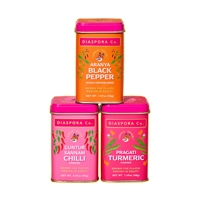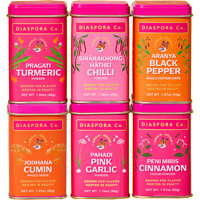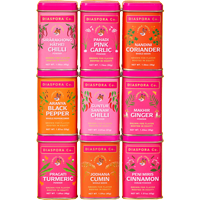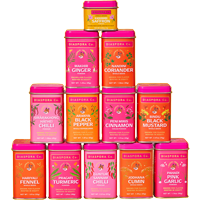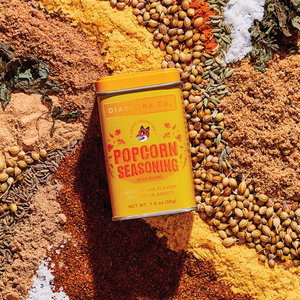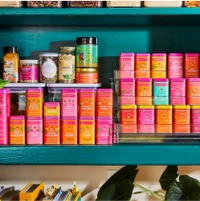As a child, I liked to stand by my mother’s elbow as she made us glasses of rose milk. I’d watch her stir a tablespoon of Rooh Afza, a syrupy, rose-flavoured drink popular throughout the subcontinent, into cold, white milk. I would be drawn to the swirl of colour that would follow the movement of her spoon. With each stir, the milk would yield to the ruby hues of Rooh Afza, until it finally turned into a delicate, fragrant pink. To me, this forever became the flavour of a rose; a memory of its colour and scent.
But this nostalgia isn’t mine alone; roses have been historically prone to poetry and romance. “It restores hearts that have gone (broken) and brings back withered souls,” wrote the Mughal Emperor Jahangir about the essence of roses in his memoir. Many years later, the evocatively named ‘Jil Jil Jigarthanda’, a cold drink from Madurai in south India, would evoke a similar sentiment, albeit without the former’s baroque prose. Jigarthanda, which literally translates to ‘heart-cooling’ in Tamil, is often tinged with rose essence, and is known to ease the heavy heat of Madurai by refreshing you from within. Even Rooh Afza in Persian translates to as “one that enhances the spirit and uplifts the soul”— creating a common thread of spiritual and emotional healing associated with roses. This isn’t surprising because the rose symbolises love, longing and beauty in cultures around the world. Perhaps this is why every dish that roses seep into are considered an indulgence, meant to be lingered over and eaten mindfully.
In restaurants and ice-cream parlours all over India, conversation and banter often drift across tall glasses of falooda, which is meant to be savoured rather than rushed. Put together with an almost ethereal list of ingredients — rose syrup, vermicelli, basil seeds, sweetened milk and ice cream — a falooda is best enjoyed as a shared experience. Even biryanis and pilafs that are often seasoned with a dab of rose water or an elegant sprinkling of dried petals are communal dishes, where large quantities are slow-cooked and shared on days meant for celebration. And while the flavour of roses is clearly meant to be relished, it isn’t always meant to be shared. Like gulkand — or a sweetened rose preserve, which is often served tightly wrapped in a betel leaf in the preparation known as paan — is a solitary pursuit. Here, the viscous, melty-sweetness of dried and candied rose petals has the capacity to slow down the world, as you bite, crunch and finally succumb.
![]()
The idea of roses may be steeped in love and poetry, but roses cultivated for essence and oil in India have mysterious origins, some of which are attributed to imperialism. The Panneer rose or Rose Edward, whose extract is widely used for food flavouring, and to make rose water, perfumes and oils, is of uncertain origins. A semi-double rose with multiple layers of petals, the R. Edward is a distinctly fragrant, perennial rose which is generally held to be the first of Bourbon roses. Conflicting theories center around the nativity of the rose but many experts agree that it probably originated in Réunion Island. A French territory, Réunion Island (previously called Bourbon Island), lies between Madgascar and Mauritius.
Around 1820, Monsieur Edouard Perichon, a superintendent in a botanical garden, is said to have noticed an extraordinarily fragrant rose that had sprung up wild, within rows of carefully raised roses. It seemed to be a natural cross between the China ‘Old Blush’ and the Autumn Damask. On being sent to France for identification, it was named Rose Edouard, now ‘Edward’. But how did this rose arrive in India? Some theories claim that it came through Pondicherry, also a French territory, while others, such as rose historian and breeder Girija Viraraghavan, believe that the rose is in fact native to certain regions in India.
Other Indian roses used for extraction have similarly untraceable origins, like the Kakinada Red. “This is again a Bourbon with a very sweet, fruity fragrance with hints of apple, quite different from the damask fragrance of R. Edward,” says Viraraghavan. DNA studies in Canada have shown that this rose is the same as the one called ‘Pacific’ in Bermuda and ‘Maggie’ in southern USA, and all of these have close links to a rose called ‘Julius Fabianics de Misefa’,which was bred by the Hungarian rose breeder, Rudolf Geschwind, in the late 1890s.
Wherever these roses may have come from, many of them thrive in the near-perfect weather conditions of India. In the south of the country, nearly every home has a cup-shaped Panneer rose, or ‘nattu roja’ (country rose) in Tamil, nodding in gardens, peeking out of windows, balconies and terraces, perfuming the air with their heady scent.
Invaders, travellers and traders are often said to have introduced new roses to the subcontinent, but India and Pakistan were never short of them. When he invaded northwest India, Alexander the Great was so taken by its diverse greenery that he is known to have sent a rose plant to his tutor and mentor, Aristotle. Vijayanagara king Krishna Deva Raya’s love for the flowers is well documented by two Portuguese travellers who visited his kingdom in south India in 1537. But these travellers, Domingo Paes and Fernaz Nuniz, found that roses were not just an indulgence of the aristocrats, but also equally loved by the common people. “They saw plantations of roses in the countryside, and the bazaars of the capital city of Hampi had many shops with baskets laden with roses,” reads an excerpt from a speech by rose historian, MS Viraraghavan.
While historical texts allude to the medicinal use of roses in Ayurveda as far as 3000 years ago, it was the Mughals who introduced roses to food in the way they’re used today. The first Mughal emperor, Babur (1483-1530), epitomized his love for roses in his poem:
'My heart, like the bud of the red, red rose,
Lies fold within fold aflame,
Would the breath of even a myriad Springs
Blow my heart's bud to a rose?'
According to the cookbook Khazana by Saliha Mahmood Ahmed, which details Indo-Persian recipes inspired by the Mughals, Babur is known to have named his daughters after roses – Gulchihra (rose-cheeked), Gulrukh (rose-faced), Gulbadan (rose-bodied) and Gulrang (rose-coloured). Akbar, who was vegetarian three times a week, was known to nourish the produce in his kitchen garden with rose water, so that vegetables would be fragrant when cooked. The Mughals had a well-known affection for roses, but it is the empress Nur Jahan’s association with roses that is significant to food history.
As with every rose story, this one also begins with beauty and poetry, along with a bit of bathwater. Nur Jahan (1577-1645), born Mehr-un-Nissa, was the most powerful woman in the Mughal empire at a time when women rarely occupied public space. She was the first woman to legislate, to determine political policies and have coins minted in her name during the reign of the Mughals in India. Amongst her many accomplishments, she is often credited with the invention of rose oil. However, it was actually her mother, Asmat Begum, who discovered the art of extracting the oil from roses that had collected in her bath water. Nur Jahan is responsible for the popularity of rose oil. She is also known to have introduced the distilling of roses to produce attar and add a dash of its flavour to sherbet, a refreshing drink made by combining rose essence and cold water.
Far from being the caricature of a classical oriental queen, the romantic partner of Jahangir, or even a scheming temptress, Nur Jahan was in fact the only Mughal queen to wield immense political clout. Widowed and 35-years-old when she married Jahangir, Nur Jahan, a Persian refugee with humble beginnings, was unusual in many ways. But it was her intelligence, refinement and love for the arts that made her a memorable ruler. Her passion for roses led to a flourishing food culture that exists to this day. Being just as artistic as she was ambitious, Nur Jahan introduced various unique new dishes to the royal Mughal court. For instance, her diplomatic association with European traders brought a few western dishes to the palace menu, interesting among which is a dish of curd set in seven moulds flavoured with rainbow-cloured fruit juices and decorated with floral patterns.
Different varieties of rose-flavoured sherbets, wine and sweetmeats including falooda are also attributed to Nur Jahan’s fine taste. She popularized paan with gulkand made from candied rose petals, not just a digestive but also an organic lipstick. There are many writers who argue that Nur Jahan invented biryani — but this claim is just as hotly disputed as it is touted. It cannot be doubted however, that Nur Jahan’s patronage of roses introduced unusual delicacies into Indian cuisine. Her attachment to the flower is attributed to a deep nostalgia for the home she had left behind. Since most memories are associated with scent, it isn’t hard to believe that the empress, also a distinguished poet, would have longed for a fragrance so old and vivid. Under her patronage, the distilleries of Kannauj were established along with many rose gardens. Many of these distilleries continue to provide essence, oil and perfume even today.
Synonymous with our fragrances, our films, our literature, our food and even our lives, the rose is unlikely to fade from our culture too soon. Every event from birth to marriage, to prayer and death is underlined by roses in a myriad ways — from the frothy, kitschy congratulations of WhatsApp forwards to the finality of tightly strung garlands at funerals.
The growing demand for roses in food and perfume has led to a burgeoning industry, with roses being exported to the US and Mecca, amongst other places. However, as the pandemic continued to overwhelm the world this year, Panneer rose farmers in Dindigul in Tamil Nadu, were seen abandoning their produce in dumpsters across flower markets. As weddings and exports were stalled, with no way to sell or preserve their roses, these farmers were forced to abandon their stock. The situation isn’t any better in Pushkar, in the northern state of Rajasthan, where sensing a dip in demand, farmers have switched to cultivating gourd and seasonal vegetables until better times prevail. Besides the threat of the pandemic, there is also the lingering concern of climate change. As the world gets drier and warmer, experts claim that cold-weather roses may not find future weather conditions ideal to survive in.
It may appear that the fate of these 35-million-year-old flowers is in question, but a quick Google search also reveals the determination of the rose enthusiast. The search shows hits for everything from raising roses in containers to growing them inside potatoes. It is also difficult to ignore the plant’s history of biological resilience — from raising spiky thorns in self-defence to climbing over walls to reach for the sun.
Synonymous with our fragrances, our films, our literature, our food and even our lives, the rose is unlikely to fade from our culture too soon. Every event from birth to marriage, to prayer and death is underlined by roses in a myriad ways — from the frothy, kitschy congratulations of WhatsApp forwards to the finality of tightly strung garlands at funerals. Some of the resilience that defines the rose is also evident in miniature paintings of Nur Jahan. In these paintings, she is often depicted in profile taking in the fragrance of a rose, her eyebrows arched, her expression thoughtful. The story of her life and her image seem to embody the spirit of her beloved flower — just as spiky and determined as it is fragile and fragrant.






